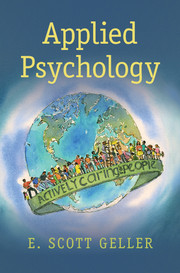Book contents
- Frontmatter
- Dedication
- Contents
- Foreword
- Preface: The Actively Caring for People (AC4P) Movement
- About the Authors
- Acknowledgments
- INTRODUCTION TO PART I EVIDENCE-BASED PRINCIPLES OF AC4P
- INTRODUCTION TO PART II APPLICATIONS OF AC4P PRINCIPLES
- 9 Actively Caring for Occupational Safety
- 10 Cultivating an AC4P Culture in Organizations
- 11 Actively Caring for Traffic Safety
- 12 Actively Caring to Prevent Alcohol Abuse
- 13 Actively Caring for Obesity
- 14 Actively Caring for Patient-Centered Healthcare
- 15 Actively Caring for Our Children
- 16 Actively Caring for Preschoolers
- 17 Actively Caring Coaching for Young Athletes
- 18 Actively Caring for Higher Education
- 19 Actively Caring for Mother Earth
- 20 The AC4P Power of Pets
- Epilogue: Where Do We Go from Here?
- Subject and Name Index
- References
20 - The AC4P Power of Pets
from INTRODUCTION TO PART II - APPLICATIONS OF AC4P PRINCIPLES
Published online by Cambridge University Press: 05 March 2016
- Frontmatter
- Dedication
- Contents
- Foreword
- Preface: The Actively Caring for People (AC4P) Movement
- About the Authors
- Acknowledgments
- INTRODUCTION TO PART I EVIDENCE-BASED PRINCIPLES OF AC4P
- INTRODUCTION TO PART II APPLICATIONS OF AC4P PRINCIPLES
- 9 Actively Caring for Occupational Safety
- 10 Cultivating an AC4P Culture in Organizations
- 11 Actively Caring for Traffic Safety
- 12 Actively Caring to Prevent Alcohol Abuse
- 13 Actively Caring for Obesity
- 14 Actively Caring for Patient-Centered Healthcare
- 15 Actively Caring for Our Children
- 16 Actively Caring for Preschoolers
- 17 Actively Caring Coaching for Young Athletes
- 18 Actively Caring for Higher Education
- 19 Actively Caring for Mother Earth
- 20 The AC4P Power of Pets
- Epilogue: Where Do We Go from Here?
- Subject and Name Index
- References
Summary
Some of our greatest historical and artistic treasures we place in museums; others, we take for walks.
– Roger CarasAre you wondering how a chapter about pets is connected to a book about using principles of humanistic behaviorism to nurture a culture of AC4P behavior? For me it's obvious, and I bet this is also the case for readers who have a pet they care for on a regular basis, especially a pet they consider part of their family.
How has your pet enriched your life? Compassionate pet owners surely actively care for their pets. And I contend the reciprocal benefits from our pets surpass any costs. How do these benefits both reflect and influence AC4P behavior? This chapter illustrates how pets, and caring for pets, can improve one's quality of life, family culture, and the human condition, as derived from both empirical research and personal experience.
MY AC4P AGENTS
Animals have always been a significant part of my life. Ever since I was able to walk, I was on the back of a pony; and ever since I was able to beg, I was asking for a kitten or a puppy to hold. Pets have been a huge inspiration for me, opening the social world, offering lasting friendships, and teaching me to cherish life itself. The positive and loyal affect pets have had on me is clear when I reflect on two of my most influential childhood pets – Goldie and Lady Champayne. I've come to understand the profound AC4P influence an animal can have on a child and the importance of a pet's AC4P-like unconditional affection. My relationship with these two special pets affected my other relationships within my family and beyond, especially facilitating my verbal interactions with others.
From a Beginning
This enriching connection with pets began when I (at age 5) put my hands around a stray cat and refused to let go, obligating my mother to bring him home. This was my pet cat – Goldie. We did more than just play together; we grew up together. We shared a unique friendship so incredible to me as a little girl that it seemed to contain the very meaning of life. At least it made my life meaningful.
- Type
- Chapter
- Information
- Applied PsychologyActively Caring for People, pp. 623 - 644Publisher: Cambridge University PressPrint publication year: 2016
References
- 1
- Cited by



